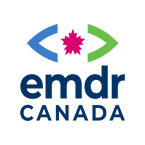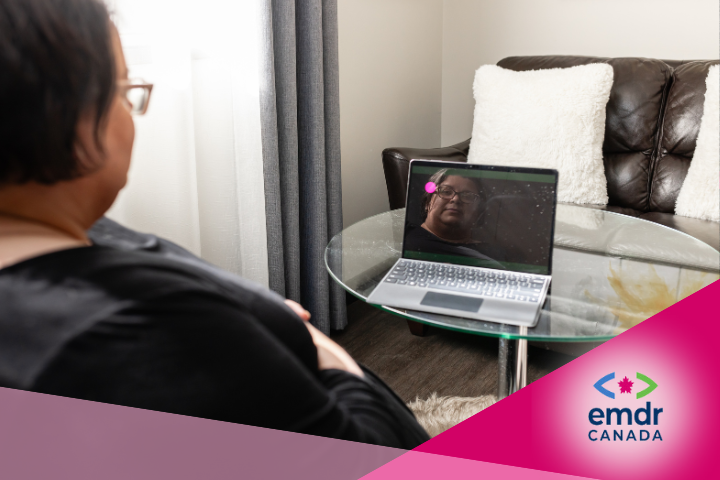In Canada, we often hear about the accessibility and affordability benefits of virtual teletherapy. With 17% of the country’s population living in a “remote area” and an often overwhelmed mental health care system, virtual treatment is a promising option for therapists and clients alike. On the other hand, it is common for therapists who practice virtually to wonder whether bottom up approaches like EMDR can be effective through a screen.
While every approach may differ, in the case of EMDR the answer is simple: Yes, virtual EMDR therapy can be highly effective. Here is what the research shows, and what Canadian EMDR therapists need to know when offering this type of therapy online.
What is the evidence for virtual EMDR therapy?
During the COVID-19 pandemic, a growing number of therapists began offering EMDR through the computer, having no other way to meet with their clients. At EMDR Canada, we had a front row seat as many therapists experienced positive clinical outcomes from eEMDR therapy this way. Their experience is substantiated by several studies, including but not limited to:
- An evaluation of eye movement desensitization and reprocessing therapy delivered remotely during the Covid-19 pandemic. McGowen et al (2021). BMC Psychiatry, 21, 560.
- Clinician and patient experience of internet-mediated eye movement desensitization and reprocessing therapy. Bursnal et al (2022). Journal of Psychosocial Rehabilitation and Mental Health, 28.
- Therapists’ experiences with the effectiveness and feasibility of video conference-based eye movement desensitization and reprocessing. Mischler et al (2021). Frontiers in Psychology: Psychology for Clinical Settings, 748712.
Studies like these (and many more) show the effectiveness of online EMDR therapy, as well as providing valuable data on the attitudes, barriers, and challenges around virtual EMDR for both clients and therapists. For example, the 2022 study from Bursnall et al. showed that initial apprehension rates were high for both therapists and clients, with 54% of therapists and 76% of clients saying they had reservations about switching to an online format for their EMDR treatment. In the end, however, 93% of clients had a positive experience with virtual EMDR therapy.
The bottom line: Research indicates that virtual EMDR can be highly effective – but if you feel reluctant about it at first, you’re certainly in good company! Preparation is key to making the transition to online EMDR a positive experience on both sides.
Do I need special training to offer EMDR online in Canada?
In Canada, the requirements to offer virtual EMDR therapy are the same as the requirements to become an EMDR therapist in-person. No additional training is required, though professional development specific to teletherapy may be advisable.
 Can children do virtual EMDR therapy?
Can children do virtual EMDR therapy?
It very much depends!
In-person therapy is often a better option when dealing with younger children (2-10 years of age). Clients in this age range typically find it easier to build relationships and maintain focus with people in the same room. Once children reach around 10 to 12 years old, there are more options for building a therapeutic relationship through screens; for example, screen-sharing word searches, the three houses exercise, or problem-solving games. Virtual EMDR can be a great option for teenagers in particular, as it can work better with their school schedules and many have a high level of comfort with online interactions.
All of these decisions need to be made on a case-by-case basis, and there is no “rule” for what age someone can start virtual EMDR. For example, if a child is very much in need of EMDR and they are not able to attend in-person sessions due to distance and travel, a therapist could explore virtual options with them even if they are younger at the time of treatment.
In addition to the child’s situation, EMDR therapists should always consider own training and readiness when determining whether to see a child for EMDR treatment, either virtually or in-person. Therapists who intend to work with children should undergo training in providing EMDR to children, have a strong understanding of child development, and be able to modify their standard EMDR therapy protocol to meet their client’s developmental needs.
Is virtual EMDR a good fit for my client or practice?
Here are some questions to ask to gauge whether virtual therapy is a good fit for your client.
Does the client have a safe, comfortable, and confidential environment? Many clients enjoy the ability to participate in therapy from the comfort of home. They may feel safer and relaxed in their own space, and appreciate not needing to travel before and after an appointment. However, “home” looks different for everyone, and some spaces are not condusive to EMDR. It is important to take the environment into consideration when doing a safety check prior to virtual EMDR. Consider if there is anyone in the home who could be a danger to the client if they overhear therapy, and make sure that clients have taken steps to minimize interruptions. It is also important to have a safety plan based on their location; for example, being equipped with the contact information for emergency services and clinics in their immediate area.
Is there a plan to keep them safe in case of dissociation? Dissociation is always a risk in EMDR, and the usual tactics to support someone in these moments may not be available in virtual therapy. Some options to prepare for this possibility include having the client prepare a basket of items to support grounding and getting the phone number of a nearby emergency contact who can be called if needed.
Does their insurance cover online treatment (if applicable)? If your client plans to use insurance for their treatment, be sure that they check whether teletherapy is covered by their plan. Most insurance providers expanded their coverage for online treatments during COVID-19, but it is worth checking to prevent unwelcome surprises.
What are the pros and cons of in-person versus virtual treatment for this particular client?
There is no evidence to indicate that in-person EMDR is superior to virtual; however, since most research on EMDR is based on in-person treatment, there is a tendency to assume in-person is “better.” In reality, it can often depend on the client’s situation. As EMDR Consultant Naomi Fisher wrote in the Journal of EMDR Practice and Research (2021):
“There may be a tendency to focus on the perceived deficits of remote EMDR therapy as compared to in-person therapy, but for some clients, remote therapy may actually be superior. For those who are too anxious to leave the house or who find the environment of the therapist’s office triggering, being able to see the therapist remotely in their own home makes therapy possible. It also may make therapy more accessible for parents of young children and those with chronic health problems or caring responsibilities. It makes it easier for people to fit therapy into their working day if they cannot get time off.”
Likewise, some people may find in-person treatment more comfortable. This could especially be the case if their home environment is chaotic, or if they find it challenging to build a relationship with their therapist through a screen.
Another significant consideration is the ability to build a therapeutic relationship, as this may be easier in-person for some (and perhaps easier at home for others!). Canadian EMDR therapists must also be equipped with PIPEDA-compliant telehealth software and be confident in their ability to use their chosen BLS modality through a screen. An EMDR Consultant could be a helpful resource for therapists preparing to offer EMDR virtually.
Resources for teletherapy practitioners looking to offer EMDR
While this article is designed to give therapists an introduction to offering EMDR virtually in the Canadian context, there are many international sources of information that can be valuable as you start out. We encourage therapists to check out these resources, and to contact us with any additional questions you may have about this topic.
“Guidelines for Virtual Delivery of EMDR Therapy” – This detailed report and accompanying poster from EMDRIA is an essential resource for anyone offering online EMDR therapy, covering ethical, technological, and preparedness considerations for anyone offering this therapy.
“Using EMDR to Treat Clients Remotely” – This helpful article in the Journal of EMDR Practice and Research was written by EMDR Consultant Dr. Naomi Fisher, who has co-authored multiple articles on the topic of virtual EMDR therapy. The article walks through each step in the EMDR process, providing detailed adaptations and preparations for many aspects of EMDR including taking SUDS ratings, maintaining dual focus, and managing dissociation and unpredictability.
To find an EMDR Consultant in Canada to help you effectively offer EMDR virtually, please visit our Map of EMDR therapists and consultants.

